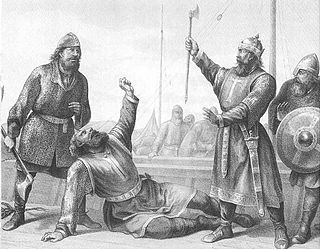
Olaf II Haraldsson, later known as St. Olaf, was King of Norway from 1015 to 1028. He was posthumously given the title Rex Perpetuus Norvegiae and canonised at Nidaros (Trondheim) by Bishop Grimkell, one year after his death in the Battle of Stiklestad on 29 July 1030. His remains were enshrined in Nidaros Cathedral, built over his burial site. His sainthood encouraged the widespread adoption of the Christian religion among the Vikings / Norsemen in Scandinavia.

Olaf Haraldsson, known as Olaf Kyrre, ruled Norway as from 1067 until his death in 1093.
Magnus Haraldsson was King of Norway from 1066 to 1069, jointly with his brother Olaf Kyrre from 1067. He was not included in official Norwegian regnal lists until modern times, but has since been counted as Magnus II.
Nidaros, Niðarós or Niðaróss was the medieval name of Trondheim when it was the capital of Norway's first Christian kings. It was named for its position at the mouth of the River Nid.
Olaf Haraldsson may refer to:

The Battle of Stiklestad in 1030 is one of the most famous battles in the history of Norway. In this battle, King Olaf II of Norway was killed. During the pontificate of Pope Alexander III, the Roman Catholic Church declared Olaf a saint in 1164.

Olsok is a national day of celebration in the Nordic countries of Norway and the Faroe Islands, and also in the provinces of Härjedalen in Sweden and Savonlinna in Finland.
Håkon Grjotgardsson was the first Earl of Lade and an ally of Harald Fairhair, King of Norway.
Olaf Haraldsson, was a reputed son of King Harald Fairhair of Norway with Svanhild Eysteinsdottir, daughter of Øystein Jarl.

Haakon Ericsson was Earl of Lade and governor of Norway as a vassal under Knut the Great.

Stiklestad is a village and parish in the municipality of Verdal in Trøndelag county, Norway. It is located 4 kilometres (2.5 mi) east of the town of Verdalsøra and about 2 kilometres (1.2 mi) southeast of the village of Forbregd/Lein. The village is mainly known as the site of the Battle of Stiklestad on 29 July 1030. Stiklestad Church is located in the village and it is assumed to have been erected on the exact spot where King Olaf II Haraldsson fell in the battle. The king was buried in Nidaros (Trondheim), canonised there on 3 August 1031, and later enshrined in Nidaros Cathedral. Following the Lutheran reformation of 1537 the saint's remains were removed and their precise resting-place has been unknown since 1568.
Eystein Meyla was elected a rival King of Norway during the Norwegian Civil War period.

Erling Skjalgsson was a Norwegian political leader of the late 10th and early 11th century. He has been commonly seen as this period's foremost defender of the historic Norwegian social system. Erling fought for the traditional small, autonomous kingdoms and the þing system, against the reformists of the Fairhair family line.
Bjørn Farmann was a king of Vestfold. Bjørn was one of the sons of Harald Fairhair, the first king of Norway. In late tradition, Bjørn Farmann was made the great-grandfather of Olaf II of Norway, through a son Gudrød Bjørnsson.

Saint Sigfrid of Sweden (Swedish: Sigfridaer, Latin: Sigafridus, Icelandic: Sigurðr Old English: Sigefrið/Sigeferð) was a missionary-bishop in Scandinavia during the first half of the 11th century. Originally from England, Saint Sigfrid is credited in late medieval king-lists and hagiography with performing the baptism of the first monarch of Sweden, Olof Skötkonung. He most likely arrived in Sweden soon after the year 1000 and conducted extensive missions in Götaland and Svealand. For some years after 1014, following his return to England, Sigfrid was based in Trondheim, Norway. However, his position there became untenable after the defeat of Olaf Haraldsson.
Jon Haraldsson was a Norwegian noble who served as the Jarl of Orkney between 1206 and 1231. Jon Haraldsson and his brother David were the sons of Harald Maddadsson with his second wife Hvarflod, daughter of Earl Máel Coluim of Moray. Jon and David were joint Earls of Orkney after the death of their father in 1206. David Haraldsson died of sickness in 1214, leaving Jon Haraldsson to rule alone. William the Lion, king of Scotland, took Jon's daughter hostage in August 1214 as part of a peace agreement with the new sole Earl.

The Archdiocese of Nidaros was the metropolitan see covering Norway in the later Middle Ages. The see was the Nidaros Cathedral, in the city of Nidaros. The archdiocese existed from the middle of the twelfth century until the Protestant Reformation.
Events in the year 1155 in Norway.
Events in the year 1157 in Norway.










